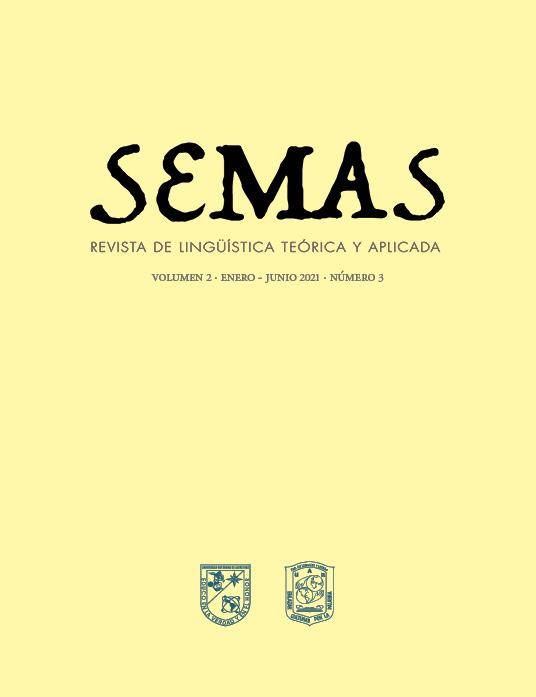Resumen
This paper contributes new evidence of the evidential and stance-taking functions of prosody in reported speech. Analysis of direct reported speech in an understudied vernacular Spanish suggests that prosody: (1) marks the boundaries of reported speech, (2) marks boundaries between multiple story-world voices, and (3) serves as a stance-taking device. Pitch average and, to a lesser extent, pitch range, were found to play a role in contextualizing reported speech. Pitch shifts tended to accompany reported speech as a unit rather than centering on a flanking intonational phrase boundary, although post-hoc analysis suggests an effect for prosodic breaks preceding reported speech. A mixed-methods analysis answers a call to assess the simultaneous functions of prosody in marking reported speech and in stance-taking. Pitch changes consistently marked dialogic reported speech, while changes in voice quality, rate, and rhythm variably accompanied salient linguistic markers in the reported speech of in- and out-group characters.
Referencias
Aikhenvald, A. (2004). Evidentiality. Oxford: Oxford University Press.Auer, P. (Ed.). (2007). Style and social identities: Alternative approaches to linguistic heterogeneity. Berlin: Mouton de Gruyter.
Bakhtin, M. M. (1981). “Discourse in the novel.” In M. Holquist (Ed.), The dialogic imagination (pp. 259-422). Austin: University of Texas Press.
Biber, D. & Finegan, E. (1988). “Adverbial stance types in English.” Discourse Processes, 11, pp. 1-34.
Bolden, G. (2004). “The quote and beyond: Defining boundaries of reported speech in conversational Russian.” Journal of Pragmatics, 36(6 ), pp. 1071-1118.
Bucholtz, M. (2005). “Identity and interaction: A sociocultural linguistic approach.” Discourse Studies, 7(4-5), pp. 585- 614.
Cabedo, A. (2007). “Caracterización prosódica del estilo directo de habla en la con-versación coloquial.” Estudios de Lingüí stica Universidad de Alicante, 21, pp. 1-13.
Canellada, M. J. y Madsen, J.K. (1987). Pronunciación del español. Lengua hab-lada y literaria. Madrid: Castalia.
Chafe, W. & Nichols, J. (Eds.). (1986). Evidentiality: The linguistic coding of epistemology. Norwood, N. J.: Ablex.
Chappell, W. (2015). “Formality strategies in Managua, Nicaragua: A local vs. global approach.” Spanish in Context, 12(2), pp. 221-254.
Christiansen, A. (2014). “El vos es el dialecto que inventamos nosotros, la forma correcta es el tú.” Borealis: An International Journal of Hispanic Linguistics, 3(2), pp. 259-297.
Coulmas, F. (Ed.). (1986). Reported speech: Some general issues. Direct and indirect speech. Berlin: Mouton de Gruyter.
Couper-Kuhlen, E. (1998). “Coherent voicing: On prosody in conversational reported speech.” Pragmatics and Beyond New Series, pp. 11-34.
Diewald, G. & Smirnova, E. (Eds.). (2010). Linguistic realization of evidentiality in European languages. Berlin/New York: De Gruyter Mouton.
Eckert, P. (2008). “Variation and the indexical field.” Journal of Sociolinguistics, 12(4), pp. 453-476.
Estellés-Arguedas, M. (2015). “Expressing evidentiality through prosody? Pro-sodic voicing in reported speech in Spanish colloquial conversations.” Journal of Pragmatics, 85, pp. 138-154.
Estellés-Arguedas, M. & Albelda Marco, M. (2014). “Evidentials, politeness and prosody in Spanish: A corpus analysis.” Journal of Politeness Research, 10(1), pp. 29-62.
Goffman, E. (1981). Forms of talk. Philadelphia: University of Pennsylvania Press.
Goodwin, C. (2007). “Interactive footing.” In E. Holt & R. Clift (Eds.), Report-ing talk: Reported speech in interaction (pp. 16-46). Cambridge: Cambridge University Press.
Gumperz, J. J. & Cook-Gumperz, J. (1982). “Introduction: Language and the communication of social identity.” Language and Social Identity, pp. 1-21.
Günthner, S. (1997). “The contextualization of affect in reported dialogues.” In S. Niemeier & R. Dirven (Eds.), The language of emotions. Conceptualization, expression, and theoretical foundation (pp. 247-276). Amsterdam: Benjamins.
Günthner, S. (1999). “Polyphony and the ‘layering of voices’ in reported dia-logues: An analysis of the use of prosodic devices in everyday reported speech.” Journal of Pragmatics, 31(5), pp. 685-708.
Jansen, W., Gregory, M. L. and Brenier, J. M. (2001). “Prosodic correlates of directly reported speech: Evidence from conversational speech.” In ISCA Tutorial and Research Workshop (ITRW) on Prosody in Speech Recognition and Understanding.
Klewitz, G. & Couper-Kuhlen, E. (1999). “Quote-unquote? The role of prosody in the contextualization of reported speech sequences.” Journal of Pragmatics, 9(4), pp. 459-485.
Lipski, J. M. (1994). Latin American Spanish. London: Longman.Lipski, J. M. (2008). Varieties of Spanish in the United States. Georgetown Uni-versity Press.
Maier, E. (2014). “Japanese reported speech: Towards an account of perspective shift as mixed quotation.” In E. McCready, K. Yabushita & K. Yoshimoto (Eds.), Formal approaches to semantics and pragmatics: Japanese and beyond(pp. 135-154). Netherlands: Springer.
Maldonado, C. (1999). “Discurso directo y discurso indirecto.” En I. Bosque y V. Demonte (Eds.), Gramática descriptiva de la lengua española (vol. 3), (pp. 3549-3596). Madrid: Espasa Calpe.
Navarro Tomás, T. (1944). Manual de entonación española. New York: Hispanic Institute in the United States (1974. 4th ed. Madrid: Ediciones Guadarrama).
Ochs, E. & Capps, L. (1996). “Narrating the self.” Annual Review of Anthropology, 25(1), pp. 19-43.
Oliveira Jr, M. & Cunha, D. A. (2004). “Prosody as marker of direct reported speech boundary.” In Speech Prosody 2004, International Conference.
Quilis, A. (1993) Tratado de fonología y fonética españolas. Madrid: Arco.
Selting, M., Auer, P., Barden, B., Bergmann, J., Couper-Kuhlen, E., Günth-ner, S., Meier, C., Quasthoff, U., Schlobinski, P. & Uhmann, S. (1998). “Gesprächsanalytisches transkriptionssystem (GAT).” Linguistische Berichte, 34(173), pp. 91-122.
Tannen, D. (1986). “Introducing constructed dialogue in Greek and American conversational and literary narrative.” Direct and indirect speech, 3, pp. 11-32.

Esta obra está bajo una licencia internacional Creative Commons Atribución 4.0.
Derechos de autor 2021 Semas

